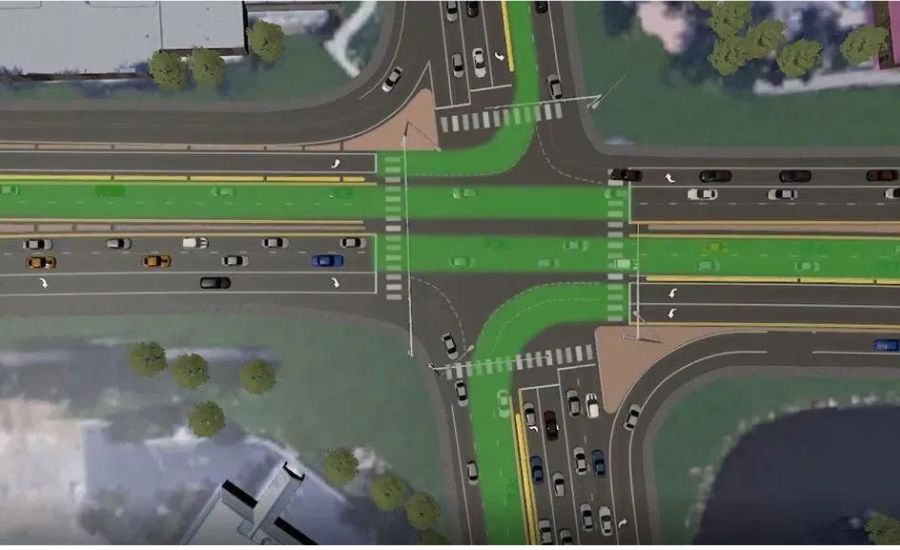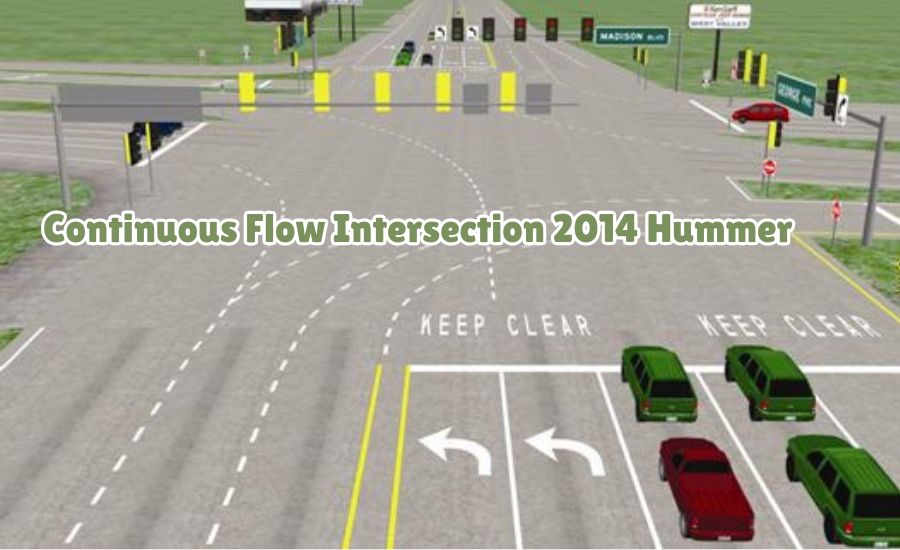The continuous flow intersection 2014 Hummer is an important topic in traffic safety. This kind of intersection was designed to help cars move better and avoid jams. However, in 2014, there was an incident involving a Hummer that made people question how safe these intersections really are.
This blog will look at what a continuous flow intersection 2014 hummer is, how it works, and what happened during the 2014 Hummer incident. We’ll also talk about why these intersections are becoming popular and what can be done to keep drivers safe.
What is a Continuous Flow Intersection?
A continuous flow intersection 2014 hummer (CFI) is a special type of intersection that helps cars move smoothly. Unlike regular intersections, CFIs allow left-turning vehicles to cross over to the left side before reaching the intersection. This design lets cars going straight and those turning left go at the same time, which reduces waiting time and traffic jams.
These intersections are very helpful in busy areas where many cars are trying to pass through. CFIs help make the roads safer by lowering the chance of accidents. By allowing cars to move more freely, they also make driving less stressful for everyone.
How Does a Continuous Flow Intersection Work?

CFIs use clever designs to improve traffic flow. First, they have special lanes that let cars turn left before reaching the intersection. This means cars that are going straight don’t have to wait for left-turning cars to clear the way.
Traffic signals at CFIs are timed to help everything run smoothly. Cars know when to go and when to stop, which keeps everything organized. Drivers can feel more confident when using these intersections because the design helps prevent confusion.
The History of Continuous Flow Intersections
continuous flow intersection 2014 hummer intersections first appeared in the 1990s as a solution to heavy traffic. Engineers wanted to find ways to make intersections work better, especially in busy cities. Over time, many places in the United States, including Virginia, started to adopt this innovative design.
In Virginia, CFIs became popular because they helped reduce delays and accidents. This led to more cities considering them as part of their traffic plans. Their growing popularity shows how effective these intersections can be for managing heavy traffic.
The 2014 Hummer Incident: What Happened?
In 2014, there was a notable incident involving a Hummer at one of Virginia’s CFIs. The Hummer collided with another car while navigating the intersection. This crash raised concerns about the safety of CFIs and how drivers understood the new traffic patterns.
Traffic authorities quickly investigated the incident. They wanted to find out if the accident was due to driver error or if there were issues with the intersection design. This incident sparked a lot of discussions about improving safety measures at CFIs.
Why Continuous Flow Intersections are Important

continuous flow intersection 2014 hummer intersections are important for many reasons. They help reduce traffic congestion, making it easier for drivers to get where they need to go. By allowing multiple types of traffic to move at once, they keep the roads more open.
Moreover, CFIs can help lower accident rates. Fewer conflict points mean there are fewer chances for cars to collide. This makes driving safer for everyone, including pedestrians and cyclists who use the same roads.
The Safety Features of Continuous Flow Intersections
Safety is a top priority in the design of continuous flow intersection 2014 hummer intersections. CFIs include dedicated turn lanes and clear traffic signals to guide drivers. These features help make sure everyone knows where to go and what to do.
Additionally, CFIs often have better signage. Signs clearly indicate when to yield or stop, which helps prevent confusion. With these safety features, drivers can feel more secure when navigating through busy intersections.
Check Out More: Dnd 5e Cradlefall
How Virginia Uses Continuous Flow Intersections
Virginia has been a leader in using continuous flow intersections. The state identified key locations where CFIs could improve traffic flow and reduce accidents. Cities like Richmond and Fairfax have seen great success with this approach.
As a result, Virginia’s transportation authorities continue to promote CFIs as part of their traffic management strategy. The positive outcomes from these intersections show how effective they can be in handling heavy traffic and improving road safety.
The Benefits of Continuous Flow Intersections for Drivers

Drivers can enjoy many benefits from using continuous flow intersection 2014 hummer intersections. One of the biggest advantages is reduced wait times. With fewer delays, drivers can reach their destinations faster and with less stress.
Another benefit is the smoother flow of traffic. CFIs help minimize sudden stops and starts, which can lead to frustration. Overall, these intersections create a more pleasant driving experience for everyone on the road.
Learning from the 2014 Hummer Incident
The 2014 Hummer incident provided valuable lessons for traffic safety. Following the crash, Virginia’s transportation officials took a closer look at how CFIs operate. They worked on improving safety protocols to help prevent future accidents.
New educational programs were developed to teach drivers about CFIs. This knowledge is essential for ensuring that everyone understands how to navigate these intersections safely.
Public Opinions on Continuous Flow Intersections
Public opinions on continuous flow intersection 2014 hummer intersections vary. Many drivers appreciate the reduced congestion and improved traffic flow. However, some feel confused by the new layout and how to navigate it.
Surveys have shown that familiarity with CFIs increases overall satisfaction. As more people use these intersections, they become more comfortable with the design and operation, leading to a positive driving experience.
Future of Continuous Flow Intersections in Traffic Management
The future of continuous flow intersection 2014 hummer intersections looks bright. As more cities face traffic challenges, CFIs are likely to be a key part of the solution. Transportation planners are considering expanding the use of CFIs in many locations.
By integrating CFIs with smart traffic systems, cities can optimize traffic flow even further. This approach will help create safer, more efficient roads for everyone.
Tips for Navigating Continuous Flow Intersections Safely

Navigating a continuous flow intersection 2014 hummer can be different, but with some tips, drivers can feel more confident. First, always pay attention to traffic signals and signs. These guide you on what to do and when to go.
Next, take your time to observe how other drivers are moving. Watching how experienced drivers handle CFIs can help you learn the best way to navigate. With practice, you’ll find that using continuous flow intersection 2014 hummer intersections becomes easier and safer over time.
Conclusion
In conclusion, continuous flow intersection 2014 hummer are a smart way to make roads safer and more efficient. They help cars move smoothly without long waits at traffic lights. By allowing cars to turn left before reaching the intersection, drivers can save time and reduce stress. Overall, CFIs make driving easier for everyone!
It’s important for drivers to understand how these intersections work. Learning about CFIs can help keep roads safe and reduce accidents. With continued use and education, continuous flow intersection 2014 hummer can become a great solution for busy areas, helping everyone get to their destinations faster and safely.
Discover More: Kevin Samuels Net Worth
FAQs
Q: What is a continuous flow intersection?
A: A continuous flow intersection 2014 hummer (CFI) is a special type of intersection that allows cars to turn left before reaching the intersection, improving traffic flow and reducing wait times.
Q: Why are continuous flow intersections used?
A: CFIs are used to reduce traffic congestion and improve safety by allowing multiple traffic movements to happen at the same time.
Q: Where are continuous flow intersections commonly found?
A: They are commonly found in busy urban areas, especially in states like Virginia, where traffic flow needs to be managed better.
Q: What happened in the 2014 Hummer incident?
A: In 2014, a Hummer was involved in a collision at a continuous flow intersection 2014 hummer intersection, raising concerns about driver understanding of these intersections.
Q: How can drivers navigate continuous flow intersections safely?
A: Drivers can navigate safely by paying attention to traffic signals and signs, observing other drivers, and practicing their navigation skills.
Q: What are the benefits of continuous flow intersections?
A: The benefits include reduced wait times, improved traffic flow, and lower accident rates, making driving more enjoyable.
Q: What should I do if I’m confused at a continuous flow intersection?
A: If you’re confused, slow down, look for signs, and observe how other drivers navigate. With practice, you’ll get more comfortable using CFIs.
